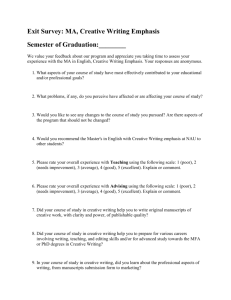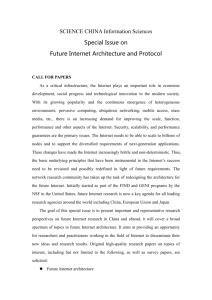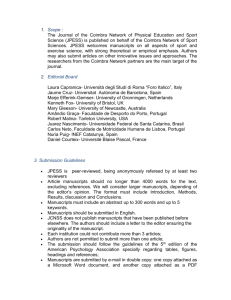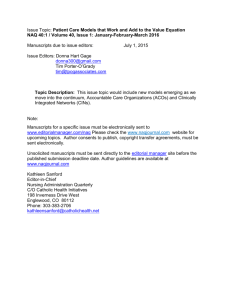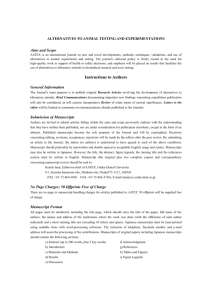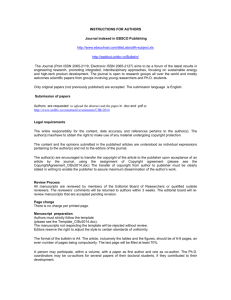Instructions to authors
advertisement
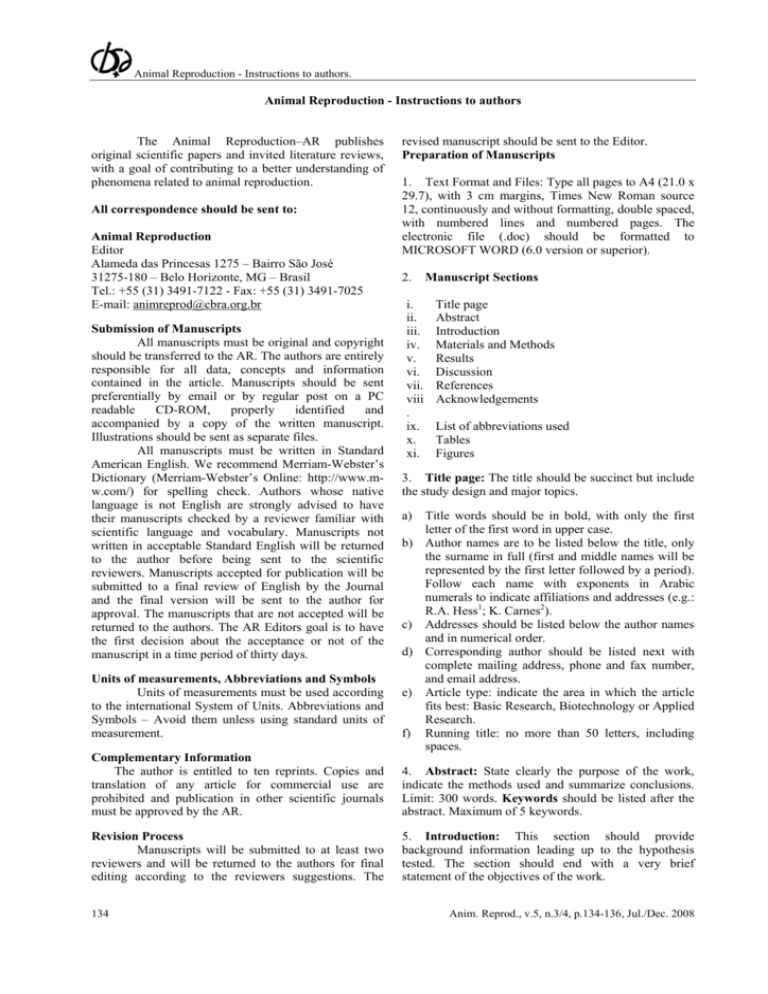
Animal Reproduction - Instructions to authors. Animal Reproduction - Instructions to authors The Animal Reproduction–AR publishes original scientific papers and invited literature reviews, with a goal of contributing to a better understanding of phenomena related to animal reproduction. All correspondence should be sent to: Animal Reproduction Editor Alameda das Princesas 1275 – Bairro São José 31275-180 – Belo Horizonte, MG – Brasil Tel.: +55 (31) 3491-7122 - Fax: +55 (31) 3491-7025 E-mail: animreprod@cbra.org.br Submission of Manuscripts All manuscripts must be original and copyright should be transferred to the AR. The authors are entirely responsible for all data, concepts and information contained in the article. Manuscripts should be sent preferentially by email or by regular post on a PC readable CD-ROM, properly identified and accompanied by a copy of the written manuscript. Illustrations should be sent as separate files. All manuscripts must be written in Standard American English. We recommend Merriam-Webster’s Dictionary (Merriam-Webster’s Online: http://www.mw.com/) for spelling check. Authors whose native language is not English are strongly advised to have their manuscripts checked by a reviewer familiar with scientific language and vocabulary. Manuscripts not written in acceptable Standard English will be returned to the author before being sent to the scientific reviewers. Manuscripts accepted for publication will be submitted to a final review of English by the Journal and the final version will be sent to the author for approval. The manuscripts that are not accepted will be returned to the authors. The AR Editors goal is to have the first decision about the acceptance or not of the manuscript in a time period of thirty days. Units of measurements, Abbreviations and Symbols Units of measurements must be used according to the international System of Units. Abbreviations and Symbols – Avoid them unless using standard units of measurement. revised manuscript should be sent to the Editor. Preparation of Manuscripts 1. Text Format and Files: Type all pages to A4 (21.0 x 29.7), with 3 cm margins, Times New Roman source 12, continuously and without formatting, double spaced, with numbered lines and numbered pages. The electronic file (.doc) should be formatted to MICROSOFT WORD (6.0 version or superior). 2. i. ii. iii. iv. v. vi. vii. viii . ix. x. xi. Manuscript Sections Title page Abstract Introduction Materials and Methods Results Discussion References Acknowledgements List of abbreviations used Tables Figures 3. Title page: The title should be succinct but include the study design and major topics. a) Title words should be in bold, with only the first letter of the first word in upper case. b) Author names are to be listed below the title, only the surname in full (first and middle names will be represented by the first letter followed by a period). Follow each name with exponents in Arabic numerals to indicate affiliations and addresses (e.g.: R.A. Hess1; K. Carnes2). c) Addresses should be listed below the author names and in numerical order. d) Corresponding author should be listed next with complete mailing address, phone and fax number, and email address. e) Article type: indicate the area in which the article fits best: Basic Research, Biotechnology or Applied Research. f) Running title: no more than 50 letters, including spaces. Complementary Information The author is entitled to ten reprints. Copies and translation of any article for commercial use are prohibited and publication in other scientific journals must be approved by the AR. 4. Abstract: State clearly the purpose of the work, indicate the methods used and summarize conclusions. Limit: 300 words. Keywords should be listed after the abstract. Maximum of 5 keywords. Revision Process Manuscripts will be submitted to at least two reviewers and will be returned to the authors for final editing according to the reviewers suggestions. The 5. Introduction: This section should provide background information leading up to the hypothesis tested. The section should end with a very brief statement of the objectives of the work. 134 Anim. Reprod., v.5, n.3/4, p.134-136, Jul./Dec. 2008 Animal Reproduction - Instructions to author. 6. Methods: Should include the design of the study, type of materials involved, number of animals per group, a clear description of all methods used and/or clear references to published methods, and the type of analysis used. 7. Results: The results section may be broken into subsections with short, informative headings. State clearly and objectively the main results found. 8. Discussion: This section may be broken into subsections with short, informative headings. The discussion should be focused on the results found. It is recommended that the main conclusions supported by the research data be stated as a last paragraph. 9. Acknowledgments: Should be briefly expressed. Grant support with the author initials (i.e., DHP) should be indicated in this section. 10. Tables: A set of alphanumerical data that is organized in lines and columns. Begin each table on a new page. Tables must be as simple as possible and only horizontal lines should be used at the top and bottom of the table. The table legend, at the top, must receive initially the word Table, followed by its number in Arabic numerals and referred to in the text as Table. The legends of the tables must be sent separately. 11. Figures and figure legends: Any illustration that contains line drawings, photographs, graphics, schemes, fluxograms etc. are considered as figures. They should be identified and sent in separate file. The list of table titles and figure legends should begin on a new page within the text. In the text refers to the figures in the numerical order that they are listed; i.e., Fig. 1, Fig. 2, Figs. 1-2, etc. The legends of the figures must be sent separately. 12. References: Begin the reference list on a new page. Please see below examples for references cited in the text and for the reference list. TEXT CITATION - Indication of the source parenthetically after the citation in order to avoid interruption in the sequence of the text. In case the names of the authors are integrated in the text, the date of publication is mentioned between parenthesis, after the name of the author, according to the examples: a) sole author: (Ginther, 1992) or Ginther (1992). b) two authors: (Varley and Foxcroft, 1990) or Varley and Foxcroft (1990). c) more than two authors: (Quintero et al., 2000) or Quintero et al. (2000). d) more than one paper cited: (Varley and Foxcroft, 1990; Ginther, 1992; Gastal et al., 1999a; b; Quintero et al., 2000) or Varley and Foxcroft (1990); Ginther (1992); Gastal et al., (1999a; b); Quintero et al. (2000), always cited in ascending Anim. Reprod., v.5, n.3/4, p.134-136, Jul./Dec. 2008 chronological order. REFERENCE LIST - Cite only referred, published work. Use "in press" only when formal acceptance has been granted. References must be listed in alphabetical order. • For PERIODICALS Gastal EL, Gastal MO, Ginther OJ. 1999a. Experimental assumption of dominance by a smaller follicle and associated hormonal changes in mares. Biol Reprod, 61:724–730. Gastal EL, Donadeu FX, Gastal MO, Ginther OJ. 1999b. Echotextural changes in the follicular wall during follicle deviation in mares. Theriogenology, 52:803-814. Hess RA, Carnes K. 2004. The role of estrogen in testis and the male reproductive tract: a review and species comparison. Anim Reprod, 1:5-30. Sartori R, Souza AH, Guenther JN, Caraviello DZ, Geiger LN, Schenk JL, Wiltbank MC. 2004. Fertilization rate and embryo quality in superovulated Holstein heifers artificially inseminated with X-sorted or unsorted sperm. Anim Reprod, 1:86-90, 2004. Varley MA, Foxcroft GR. 1990. Endocrinology of lactating and weaned sow. J Reprod Fertil Suppl, 40:4761. • For OTHER DOCUMENTS than periodicals Basrur PK, Yusoff RBH. 1997. Sex anomalies in goats. In Youngquist, RS (Ed.). Current therapy in large animal theriogenology. Philadelphia, USA: WB Saunders. pp.253-290 Ginther OJ. 1992. Reproductive biology of the mare: Basic and applied aspects. 2.ed. Cross Plains, WI, USA: Equiservices Publishing. pp.105-172. Leal MC. 2004. Morphometric and functional analyses of testis and spermatogenic efficiency in the marmoset (Callithrix penicillata) [in Portuguese]. Belo Horizonte, Brazil: Federal University of Minas Gerais. Thesis. Quintero B, Porter M, Sharp D, Cleaver B, Diaz T. 2000. Effect of season on LH concentrations and LH pulse dynamics in mares located in the tropics. In Abstracts of the 14th International Congress on Animal Reproduction, 2000, Stockholm, Sweden. Stockholm: ICAR. pp .290. • For ELECTRONIC DOCUMENTS CD-ROM Anderson SC, Poulsen KB. 2002. Anderson's electronic atlas of hematology [CD-ROM]. Philadelphia: Lippincott Williams & Wilkins. Journal article on the Internet Abood S. 2002. Quality improvement initiative in nursing homes: the ANA acts in an advisory role. Am J 135 Animal Reproduction - Instructions to author. Nurs [serial on the Internet], 102: 3pp. Available in: http://www.nursingworld.org/AJN/2002/june/Wawatch. htm. Accessed in: Aug 12th 2002. Monograph on the Internet Foley KM, Gelband H. (Eds.). 2001. Improving palliative care for cancer [monograph on the Internet]. Washington: National Academy Press. Available from: http://www.nap.edu/books/0309074029/html/. Accessed in: July 9th. 2002. Homepage/Web site Cancer-Pain.org [homepage on the Internet]. 2002. New York: Association of Cancer Online Resources, Inc. Available in: http://www.cancer-pain.org/. Accessed in: Jul 9th. 2002. Part of a homepage/Web site American Medical Association [homepage on the Internet]. 2001. Chicago: The Association. Available from: http://www.ama-assn.org/ama/pub/category/ 1736.html. Accessed in: Aug 12th. 2002. Database on the Internet Open database: Who's Certified [database on the Internet]. 2000. Evanston, IL: The American Board of Medical Specialists. Available from: http://www.abms.org/newsearch.asp. Accessed in: Mar 8th. 2001. Closed database: Jablonski S. 2001. Online Multiple Congential Anomaly/Mental Retardation (MCA/MR) syndromes [database on the Internet]. Bethesda, MD: National 136 Library of Medicine. Available from: http://www.nlm.nih.gov/mesh/jablonski/syndrome_title. html. Accessed in: Aug 12th. 2002. Part of a database on the Internet MeSH Browser [database on the Internet]. 2002. Bethesda, MD: National Library of Medicine. Metaanalysis; unique ID: D015201; [3pp.]. Available from: http://www.nlm.nih.gov/mesh/MBrowser.html Files updated weekly. Accessed in: Jun 10th. 2003. • NON PUBLISHED WORK – Should be mentioned only in the text and not in the list of references. • VERBAL INFORMATION - References concerning unpublished data and “personal communications” should not be cited in the reference list but should be mentioned in the text. After the information, the author must put the expression “verbal information" or "personal communication"). 13. There is no page charges and figures limit. Particularly in case of colorful pictures please contact the editors. 14. If you have any question please report to the Animal Reproduction Website (http//www.cbra.org.br/animreprod) and see previously published articles. Anim. Reprod., v.5, n.3/4, p.134-136, Jul./Dec. 2008
